Preferences#
Starting with version 0.4.6, napari provides persistent settings.
Settings are managed by getting the global settings object:
from napari.settings import get_settings
settings = get_settings()
# then modify... e.g:
settings.appearance.theme = 'dark'
Sections#
The settings are grouped by sections and napari core provides the following:
APPLICATION#
Main application settings.
Confirm window or application closing#
Ask for confirmation before closing a napari window or application (all napari windows).
Access programmatically with
SETTINGS.application.confirm_close_window.Type:
bool.Default:
True.UI: This setting can be configured via the preferences dialog.
Console notification level#
Select the notification level for the console.
Access programmatically with
SETTINGS.application.console_notification_level.Type:
NotificationSeverity.Default:
<NotificationSeverity.NONE: 'none'>.UI: This setting can be configured via the preferences dialog.
Dask cache#
Settings for dask cache (does not work with distributed arrays)
Access programmatically with
SETTINGS.application.dask.Type:
DaskSettings.Default:
DaskSettings(enabled=True, cache=16.837476352).UI: This setting can be configured via the preferences dialog.
First time#
Indicate if napari is running for the first time. This setting is managed by the application.
Access programmatically with
SETTINGS.application.first_time.Type:
bool.Default:
True.
Grid Height#
Number of rows in the grid.
Access programmatically with
SETTINGS.application.grid_height.Type:
ConstrainedIntValue.Default:
-1.UI: This setting can be configured via the preferences dialog.
Grid Stride#
Number of layers to place in each grid square.
Access programmatically with
SETTINGS.application.grid_stride.Type:
ConstrainedIntValue.Default:
1.UI: This setting can be configured via the preferences dialog.
Grid Width#
Number of columns in the grid.
Access programmatically with
SETTINGS.application.grid_width.Type:
ConstrainedIntValue.Default:
-1.UI: This setting can be configured via the preferences dialog.
GUI notification level#
Select the notification level for the user interface.
Access programmatically with
SETTINGS.application.gui_notification_level.Type:
NotificationSeverity.Default:
<NotificationSeverity.INFO: 'info'>.UI: This setting can be configured via the preferences dialog.
IPython interactive#
Toggle the use of interactive %gui qt event loop when creating napari Viewers in IPython.
Access programmatically with
SETTINGS.application.ipy_interactive.Type:
bool.Default:
True.
Language#
Select the display language for the user interface.
Access programmatically with
SETTINGS.application.language.Type:
Language.Default:
'en'.UI: This setting can be configured via the preferences dialog.
Opened folders history#
Last saved list of opened folders. This setting is managed by the application.
Access programmatically with
SETTINGS.application.open_history.Type:
List[str].Default:
[].
Playback frames per second#
Playback speed in frames per second.
Access programmatically with
SETTINGS.application.playback_fps.Type:
int.Default:
10.UI: This setting can be configured via the preferences dialog.
Playback loop mode#
Loop mode for playback.
Access programmatically with
SETTINGS.application.playback_mode.Type:
LoopMode.Default:
<LoopMode.LOOP: 'loop'>.UI: This setting can be configured via the preferences dialog.
Preferences size#
Last saved width and height for the preferences dialog. This setting is managed by the application.
Access programmatically with
SETTINGS.application.preferences_size.Type:
Optional[Tuple[int, int]].Default:
None.
Saved folders history#
Last saved list of saved folders. This setting is managed by the application.
Access programmatically with
SETTINGS.application.save_history.Type:
List[str].Default:
[].
Save window geometry#
Toggle saving the main window size and position.
Access programmatically with
SETTINGS.application.save_window_geometry.Type:
bool.Default:
True.UI: This setting can be configured via the preferences dialog.
Save window state#
Toggle saving the main window state of widgets.
Access programmatically with
SETTINGS.application.save_window_state.Type:
bool.Default:
False.UI: This setting can be configured via the preferences dialog.
Window fullscreen#
Last saved fullscreen state for the main window. This setting is managed by the application.
Access programmatically with
SETTINGS.application.window_fullscreen.Type:
bool.Default:
False.
Window maximized state#
Last saved maximized state for the main window. This setting is managed by the application.
Access programmatically with
SETTINGS.application.window_maximized.Type:
bool.Default:
False.
Window position#
Last saved x and y coordinates for the main window. This setting is managed by the application.
Access programmatically with
SETTINGS.application.window_position.Type:
Optional[Tuple[int, int]].Default:
None.
Window size#
Last saved width and height for the main window. This setting is managed by the application.
Access programmatically with
SETTINGS.application.window_size.Type:
Optional[Tuple[int, int]].Default:
None.
Window state#
Last saved state of dockwidgets and toolbars for the main window. This setting is managed by the application.
Access programmatically with
SETTINGS.application.window_state.Type:
Optional[str].Default:
None.
Show status bar#
Toggle diplaying the status bar for the main window.
Access programmatically with
SETTINGS.application.window_statusbar.Type:
bool.Default:
True.
APPEARANCE#
User interface appearance settings.
Highlight thickness#
Select the highlight thickness when hovering over shapes/points.
Access programmatically with
SETTINGS.appearance.highlight_thickness.Type:
ConstrainedIntValue.Default:
1.UI: This setting can be configured via the preferences dialog.
Show layer tooltips#
Toggle to display a tooltip on mouse hover.
Access programmatically with
SETTINGS.appearance.layer_tooltip_visibility.Type:
bool.Default:
False.UI: This setting can be configured via the preferences dialog.
Theme#
Select the user interface theme.
Access programmatically with
SETTINGS.appearance.theme.Type:
Theme.Default:
'dark'.UI: This setting can be configured via the preferences dialog.
PLUGINS#
Plugins settings.
Plugin sort order#
Sort plugins for each action in the order to be called.
Access programmatically with
SETTINGS.plugins.call_order.Type:
Mapping[str, List[napari.settings._plugins.PluginHookOption]].Default:
{}.UI: This setting can be configured via the preferences dialog.
Disabled plugins#
Plugins to disable on application start.
Access programmatically with
SETTINGS.plugins.disabled_plugins.Type:
Set[str].Default:
set().
File extension readers#
Assign file extensions to specific reader plugins
Access programmatically with
SETTINGS.plugins.extension2reader.Type:
Mapping[str, str].Default:
{}.UI: This setting can be configured via the preferences dialog.
Writer plugin extension association.#
Assign file extensions to specific writer plugins
Access programmatically with
SETTINGS.plugins.extension2writer.Type:
Mapping[str, str].Default:
{}.
Use npe2 adaptor#
Use npe2-adaptor for first generation plugins. When an npe1 plugin is found, this option will import its contributions and create/cache a ‘shim’ npe2 manifest that allows it to be treated like an npe2 plugin (with delayed imports, etc…)
Access programmatically with
SETTINGS.plugins.use_npe2_adaptor.Type:
bool.Default:
False.UI: This setting can be configured via the preferences dialog.
SHORTCUTS#
Shortcut settings.
shortcuts#
Set keyboard shortcuts for actions.
Access programmatically with
SETTINGS.shortcuts.shortcuts.Type:
Mapping[str, List[str]].Default:
{'napari:toggle_console_visibility': ['Control-Shift-C'], 'napari:reset_scroll_progress': ['Control'], 'napari:toggle_ndisplay': ['Control-Y'], 'napari:toggle_theme': ['Control-Shift-T'], 'napari:reset_view': ['Control-R'], 'napari:delete_selected_layers': ['Control-Delete'], 'napari:show_shortcuts': ['Control-Alt-/'], 'napari:increment_dims_left': ['Left'], 'napari:increment_dims_right': ['Right'], 'napari:focus_axes_up': ['Alt-Up'], 'napari:focus_axes_down': ['Alt-Down'], 'napari:roll_axes': ['Control-E'], 'napari:transpose_axes': ['Control-T'], 'napari:toggle_grid': ['Control-G'], 'napari:toggle_selected_visibility': ['V'], 'napari:hold_for_pan_zoom': ['Space'], 'napari:activate_labels_erase_mode': ['1'], 'napari:activate_labels_paint_mode': ['2'], 'napari:activate_labels_fill_mode': ['3'], 'napari:activate_labels_picker_mode': ['4'], 'napari:activate_labels_pan_zoom_mode': ['5'], 'napari:new_label': ['M'], 'napari:decrease_label_id': ['-'], 'napari:increase_label_id': ['='], 'napari:decrease_brush_size': ['['], 'napari:increase_brush_size': [']'], 'napari:toggle_preserve_labels': ['P'], 'napari:activate_points_add_mode': ['2'], 'napari:activate_points_select_mode': ['3'], 'napari:activate_points_pan_zoom_mode': ['4'], 'napari:activate_points_transform_mode': ['5'], 'napari:select_all_in_slice': ['A', 'Control-A'], 'napari:select_all_data': ['Shift-A'], 'napari:delete_selected_points': ['Backspace', 'Delete', '1'], 'napari:activate_add_rectangle_mode': ['R'], 'napari:activate_add_ellipse_mode': ['E'], 'napari:activate_add_line_mode': ['L'], 'napari:activate_add_path_mode': ['T'], 'napari:activate_add_polygon_mode': ['P'], 'napari:activate_add_polygon_lasso_mode': ['Shift-P'], 'napari:activate_direct_mode': ['4'], 'napari:activate_select_mode': ['5'], 'napari:activate_shapes_pan_zoom_mode': ['6'], 'napari:activate_shapes_transform_mode': ['2'], 'napari:activate_vertex_insert_mode': ['2'], 'napari:activate_vertex_remove_mode': ['1'], 'napari:copy_selected_shapes': ['Control-C'], 'napari:paste_shape': ['Control-V'], 'napari:move_shapes_selection_to_front': ['f'], 'napari:move_shapes_selection_to_back': ['b'], 'napari:select_all_shapes': ['A'], 'napari:delete_selected_shapes': ['Backspace', 'Delete', '3'], 'napari:finish_drawing_shape': ['Escape'], 'napari:activate_image_pan_zoom_mode': ['1'], 'napari:activate_image_transform_mode': ['2'], 'napari:activate_vectors_pan_zoom_mode': ['1'], 'napari:activate_vectors_transform_mode': ['2'], 'napari:activate_tracks_pan_zoom_mode': ['1'], 'napari:activate_tracks_transform_mode': ['2'], 'napari:activate_surface_pan_zoom_mode': ['1'], 'napari:activate_surface_transform_mode': ['2']}.UI: This setting can be configured via the preferences dialog.
EXPERIMENTAL#
Experimental settings.
Render Images Asynchronously#
Asynchronous loading of image data. This setting partially loads data while viewing. You must restart napari for changes of this setting to apply.
Access programmatically with
SETTINGS.experimental.async_.Type:
bool.Default:
False.UI: This setting can be configured via the preferences dialog.
Enable autoswapping rendering buffers.#
Autoswapping rendering buffers improves quality by reducing tearing artifacts, while sacrificing some performance.
Access programmatically with
SETTINGS.experimental.autoswap_buffers.Type:
bool.Default:
False.UI: This setting can be configured via the preferences dialog.
Minimum distance threshold of shapes lasso tool#
Value determines how many screen pixels one has to move before another vertex can be added to the polygon.
Access programmatically with
SETTINGS.experimental.lasso_vertex_distance.Type:
ConstrainedIntValue.Default:
10.UI: This setting can be configured via the preferences dialog.
Enable Asynchronous Tiling of Images#
Renders images asynchronously using tiles. You must restart napari for changes of this setting to apply.
Access programmatically with
SETTINGS.experimental.octree.Type:
Union[bool, str].Default:
False.UI: This setting can be configured via the preferences dialog.
Shapes polygon lasso RDP epsilon#
Setting this higher removes more points from polygons. Setting this to 0 keeps all vertices of a given polygon
Access programmatically with
SETTINGS.experimental.rdp_epsilon.Type:
ConstrainedFloatValue.Default:
0.5.UI: This setting can be configured via the preferences dialog.
Support for plugin specific settings will be provided in an upcoming release.
Changing settings programmatically#
from napari.settings import SETTINGS
SETTINGS.appearance.theme = "light"
Reset to defaults via CLI#
To reset all napari settings to the default values:
napari --reset
The preferences dialog#
Starting with version 0.4.6, napari provides a preferences dialog to manage some of the provided options.
Application#
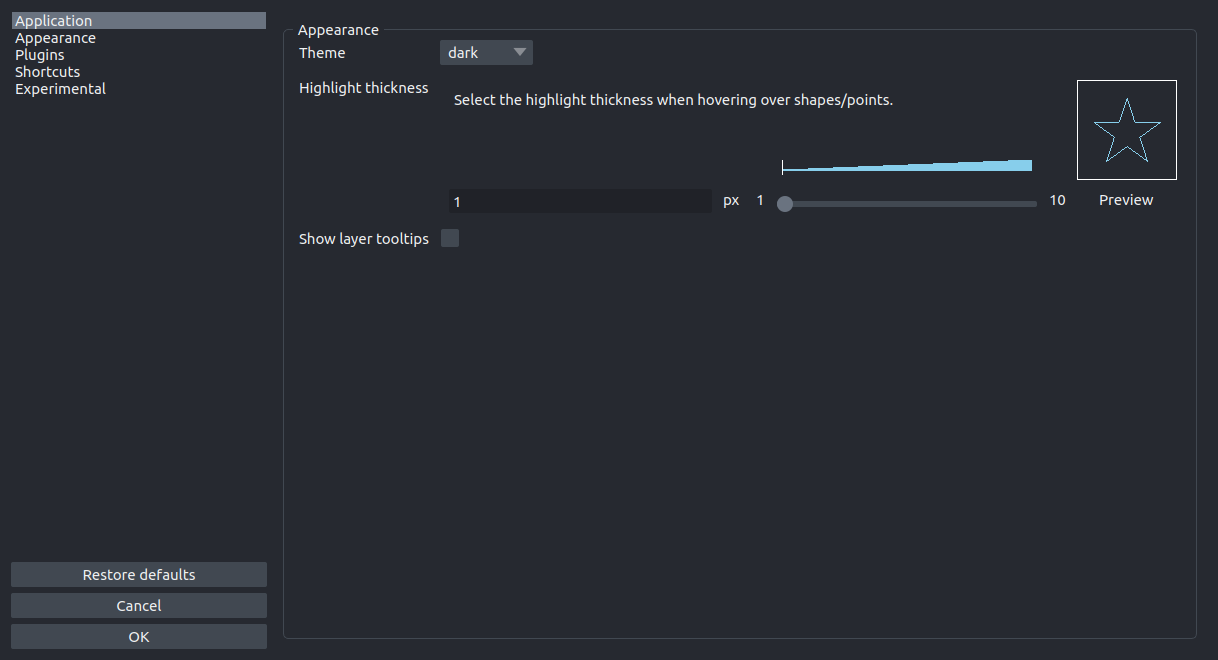
Appearance#
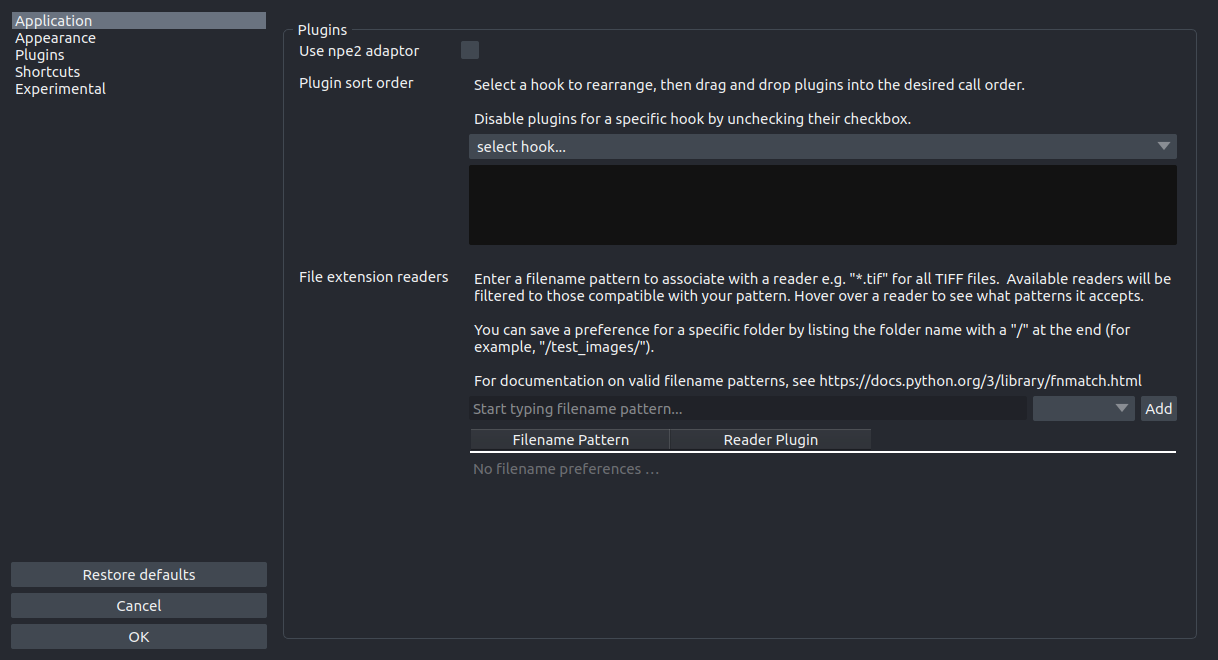
Plugins#
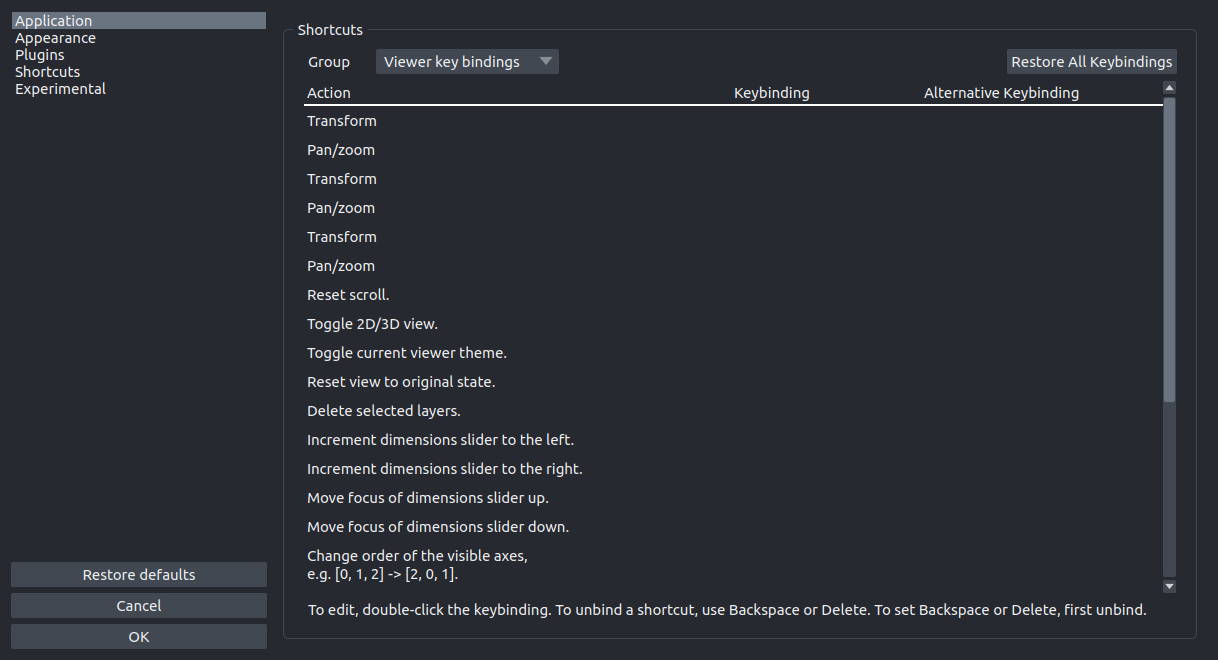
Shortcuts#
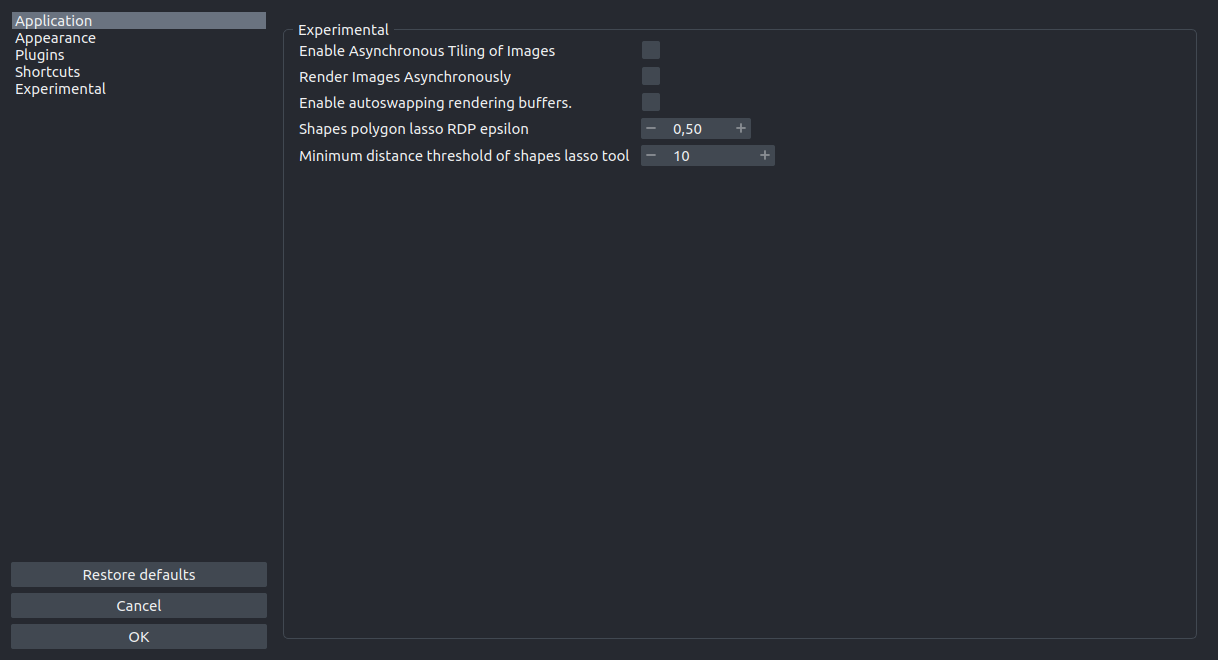
Experimental#
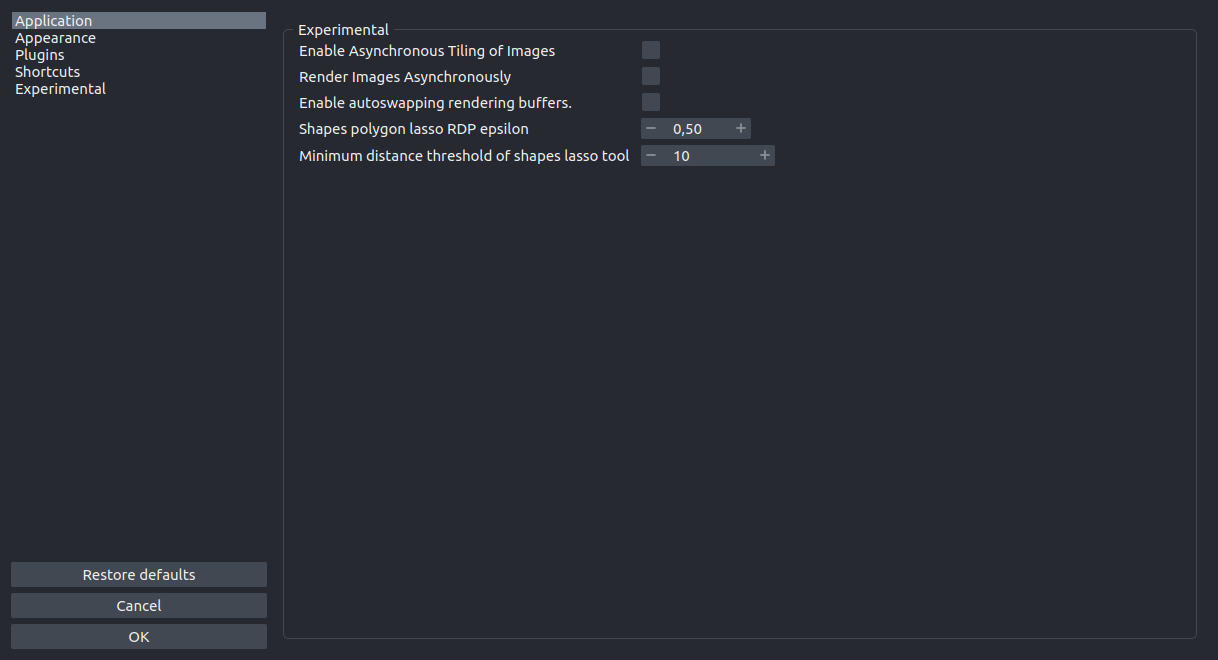
Reset to defaults via UI#
To reset the preferences click on the Restore defaults button and continue
by clicking on Restore.
